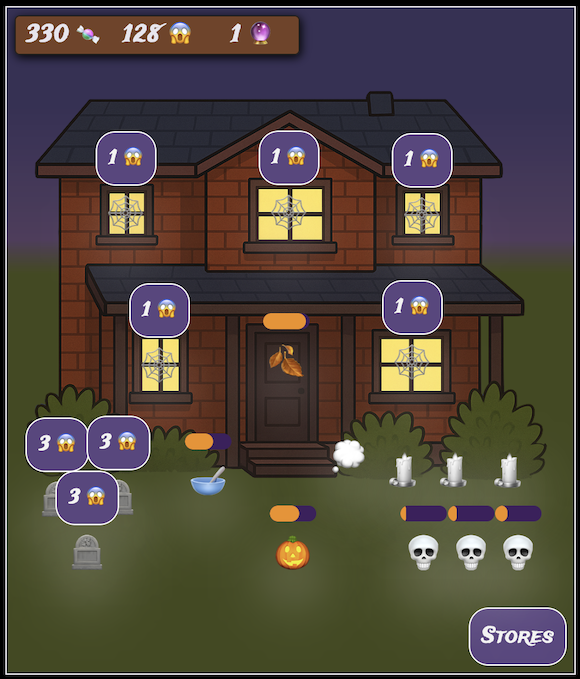Making a HTML5 Halloween Idler Game
I've been building a web-based game inspired by my (in real life) annual Halloween yard decorations. In this post, I'll discuss the game's design ethos and core mechanics.
The current development build of the game is available here.

Delight in Decoration: A Cosy Halloween Decoration Idler
Idler/incremental games are a growing genre whose general goal is to raise some numbers as high as possible. While progress is initially slow and steady, purchasing upgrades can speed up and modify the core loop. Some good examples of this genre are Insaniquarium, AdVenture Capitalist, Universal Paperclips, and The Simpsons Tapped Out (RIP).
In my game, the player decorates a house and garden for Halloween. They purchase, place, and upgrade decorations using three currencies, balancing cosy charm and spooky spectacle. As players artfully arrange their décor, hidden themes emerge, granting powerful rewards and unlocking secret stores. Ultimately, players gather enough Spirit to summon the Wonder Relic - completing their perfect Halloween tableau.
By blending the mechanics of an idler game with thematic richness, I am looking to invite exploration and personalisation and reward players for pursuing this path. For example, by thematically placing decorations, players gain a bonus. This gentle nudge towards exploring effective item combinations deepens the gameplay appeal and shifts the player's focus away from resource micromanagement. The game's discovery and emergent nature eschew traditional tutorial-based introductions. Players learn by doing.
Types of Items
- Decorations and Effects are the core items for decorating the home and garden. They output currency at a fixed interval and may have limited uses before requiring a recharge.
- Modifiers temporarily or permanently adjust a game property, such as the production rate or amount for an item type or category.
- Holders are temporary sinks of value that vary the game's tempo and regulate output. Usually, decorations and effects produce currency that goes straight to the user's wallet. Holders capture that currency until a threshold is met, at which point it's released with bonus interest.
- The Wonder Relic is an item of vast significance because it ends the game! It encapsulates the player's dominant aesthetic - exactly which relic is available for purchase is driven by the purchases made during the game.
Stores and Spending
There are three in-game currencies:
- Candy 🍬 - the currency of trick-or-treaters! Users can purchase decorations from the store using CDY. Decorations generate CDY when placed in the game world. Later in the game, CDY can be used to purchase customisations for items.
- Spooks 😱 - after all, it's not Halloween without scaring people! As the user progresses through the game, they will unlock special effects that augment the display and increase the fear factor. Think fog machines, flickering lights, and jump scares. SPK represents how scary and thematic the user's display is.
- Spirit 🔮 - the spirit of Halloween! As the user accumulates more SPK currency, they will begin to unlock methods to harvest that fear and transform it into SPR, which is the game's 'prestige' currency. SPR is used to upgrade the output of decorations, purchase big set-piece decorations, and eventually end the game by buying a 'wonder relic'.
It is typical, especially in the mobile space, for games of this genre to be heavily laden with microtransactions and for the game mechanics to nudge users towards purchasing items. After all, this provides a revenue stream for the developers. However, that's not my style, so my game won't feature digital purchases.
At the beginning of the game, only one store is available, stocking homemade and traditional Halloween decorations. These items are low-level, albeit upgradable later on. As the game progresses, new stores will unlock, such as a supermarket selling more commercial-oriented decorations and, later, a wizard's magical store that sells ostensibly more supernaturally-oriented items. This progression from traditional to supernatural evokes a sense of wonder and mystery. Further, there are secret stores that unlock only in the right conditions! These serve as a reward for exploration, offering unique, powerful decorations and effects that will differentiate the player's build.
Where Next?
At the time of writing, I've implemented many core mechanics, but I'm far from finished. As demonstrated in the screenshot, I've heavily relied on emoji instead of real game art. This approach has taken me surprisingly far into the process, allowing me to focus on building out the core mechanics. Modern browsers are good enough that they can natively handle ES Modules, meaning that I don't need to even bother with a build toolchain - that basic loop of 'make edit, hit refresh' has meant I have been able to iterate very quickly, experimenting and adapting based on feedback. Finally, I appreciate that once I get to the position of having real artwork and animations, I'll most likely need to switch to something like <canvas>, but I have been able to get this far just with native HTML elements we all know and love: <div>, <h2>, <button> and <progress>. By only using simple technology, I can retain my options for later (when I am better placed to make decisions) and not be overwhelmed upfront when I want to prototype.